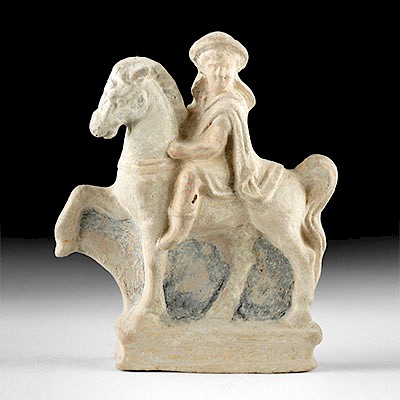Roman Green Glazed Pottery Vessel, ex-Royal Athena
Lot 40a
About Seller
Artemis Fine Arts
686 S Taylor Ave, Ste 106
Louisville, CO 80027
United States
Selling antiquities, ancient and ethnographic art online since 1993, Artemis Gallery specializes in Classical Antiquities (Egyptian, Greek, Roman, Near Eastern), Asian, Pre-Columbian, African / Tribal / Oceanographic art. Our extensive inventory includes pottery, stone, metal, wood, glass and textil...Read more
Estimate:
$2,400 - $3,600
Absentee vs Live bid
Two ways to bid:
- Leave a max absentee bid and the platform will bid on your behalf up to your maximum bid during the live auction.
- Bid live during the auction and your bids will be submitted real-time to the auctioneer.
Bid Increments
| Price | Bid Increment |
|---|---|
| $0 | $25 |
| $300 | $50 |
| $1,000 | $100 |
| $2,000 | $250 |
| $5,000 | $500 |
| $10,000 | $1,000 |
| $20,000 | $2,500 |
| $50,000 | $5,000 |
| $100,000 | $10,000 |
| $200,000 | $20,000 |
About Auction
By Artemis Fine Arts
May 9, 2019
Set Reminder
2019-05-09 10:00:00
2019-05-09 10:00:00
America/New_York
Bidsquare
Bidsquare : Ancient | Asian | Ethnographic
https://www.bidsquare.com/auctions/artemis-gallery/ancient-asian-ethnographic-4110
Featuring classical antiquities, ancient and ethnographic art from cultures encompassing the globe. All legally acquired, legal to sell. Satisfaction guaranteed. Convenient in-house shipping. Artemis Fine Arts info@artemisgallery.com
Featuring classical antiquities, ancient and ethnographic art from cultures encompassing the globe. All legally acquired, legal to sell. Satisfaction guaranteed. Convenient in-house shipping. Artemis Fine Arts info@artemisgallery.com
- Lot Description
Roman, Imperial Period, ca. 1st to 3rd century CE. A rare example of a glazed ceramic vessel, mold-made, with a beautiful floral motif in high relief around its exterior body. The vessel form is similar to a skyphos, with a round body, a pronounced foot, and two small, loop handles. A thick olive green and deep navy blue glaze covers much of the body, which has aged to have an interesting craquelured surface. Size: 4.75" W x 2.6" H (12.1 cm x 6.6 cm)
Roman glazed vessels were technically difficult to produce, and as a result are quite rare - for example, they were only produced at two locations in Roman Britain, Holt and Caerleon. Most were made in Italy, central Gaul, and possibly modern day Serbia and Romania. They were manufactured by dipping pottery items into a lead oxide "frit", a raw glaze suspended in water. When the vessel was fired, the lead oxide reacted with the silica in the clay, creating a color that ranged from yellow to green to dark brown.
See for example the lead-glazed skyphos at the British Museum: https://www.britishmuseum.org/research/collection_online/collection_object_details.aspx?objectId=466043&partId=1&searchText=roman+glazed+skyphos&images=true&page=1
Provenance: private East Coast, USA collection
All items legal to buy/sell under U.S. Statute covering cultural patrimony Code 2600, CHAPTER 14, and are guaranteed to be as described or your money back.
A Certificate of Authenticity will accompany all winning bids.
We ship worldwide and handle all shipping in-house for your convenience.
#141995Intact, with excellent craquelure on remaining glaze on surface, and light encrustation in some small areas.Condition
- Shipping Info
-
All shipping is handled in-house for your convenience. Your invoice from Artemis Gallery will include shipping calculation instructions. If in doubt, please inquire BEFORE bidding for estimated shipping costs for individual items.
-
- Buyer's Premium



 EUR
EUR CAD
CAD AUD
AUD GBP
GBP MXN
MXN HKD
HKD CNY
CNY MYR
MYR SEK
SEK SGD
SGD CHF
CHF THB
THB
















